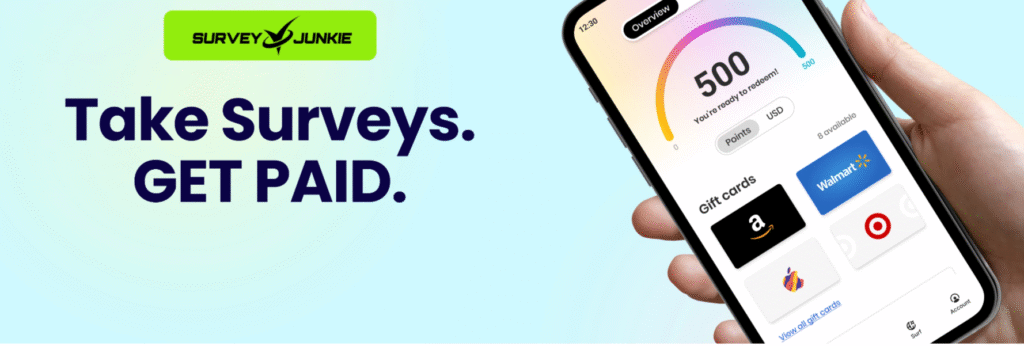Money-Making Apps: 10 Legit Ways To Make Extra Money

Look, I get it. You’re scrolling through your phone at 2 AM, wondering if there’s a way to squeeze more money out of the same 24 hours we all get. Been there, done that, bought the T-shirt (and then realized I needed to make money to pay for it).
Here’s the thing: your smartphone isn’t just for endless TikTok scrolling and arguing with strangers on the internet. It can actually become your personal money-making machine.
I’ve tested dozens of these apps over the years, and trust me, some are absolute garbage while others genuinely helped me pocket some serious extra cash.
Ready to turn your phone into a side hustle? Let’s talk about the real money-making apps that won’t leave you feeling scammed.
What Is A Money-Making App?
Think of money-making apps as your digital Swiss Army knife for earning extra income. These platforms connect you with opportunities to make cash through various activities, from micro-investing spare change to completing surveys during your lunch break.
The beauty of these apps lies in their accessibility. You don’t need a business degree or startup capital. You just need a smartphone and some spare time. Whether you want to invest your coffee money or freelance your skills, there’s probably an app for that.
But here’s where I’ll be brutally honest with you: most of these apps won’t replace your day job. They’re more like finding loose change in your couch cushions, except you’re finding it consistently, and it adds up over time.
From a financial planning perspective, I categorize money-making apps into three distinct buckets: immediate gratification (surveys, cashback), medium-term growth (gig economy), and long-term wealth building (investment platforms). Understanding this framework helps you align app selection with your financial goals and risk tolerance.
Are Money-Making Apps Real And Safe?
Short answer? Yes, many are legit. Long answer? It’s complicated.
I’ve personally used apps that have paid me thousands of dollars over the years. But I’ve also encountered apps that promised the moon and delivered pocket lint. The key is knowing how to spot the difference.
Red flags to watch for:
- Apps asking for upfront fees
- Promises of “get-rich-quick” schemes
- Vague payment structures
- Poor user reviews mentioning payment issues
- Lack of proper SSL encryption
- No clear customer service contact
Green flags that scream “legit”:
- Clear terms of service
- Transparent fee structures
- Positive user reviews with actual payment proof
- Established company backing
- Proper regulatory compliance
- Multiple payment options
From my experience as a finance professional, I always tell people to treat these apps like any other financial decision. Do your homework, read the fine print, and never invest more time or money than you can afford to lose.
Pro tip: Apply the 1% rule I use with my clients, never risk more than 1% of your total income on experimental earning methods until you’ve proven their reliability.
What Apps Are Best For Making Money?
The investment-based apps typically offer the highest earning potential. Why? Because they’re helping your money work for you instead of you working for money. It’s the difference between trading hours for dollars and making dollars while you sleep.
However, the “best” app really depends on your situation:
- Got spare time but no spare cash? Survey and task-based apps
- Have some money to invest, but are new to the world of investing? Micro-investing apps
- Possess marketable skills? Freelancing platforms
- Own assets (car, spare room)? Sharing economy apps
I personally use a mix of investment apps and freelancing platforms because they align with my skills and financial goals. Your mileage may vary.
Financial insight: The apps with the highest ROI potential are those that scale with compound growth rather than linear time investment. Think compound interest versus hourly wages, one grows exponentially, the other stays flat.
Are Money-Making Apps Reliable?
Here’s the thing: reliability isn’t just about whether they pay you (though that’s pretty important). It’s also about consistency, transparency, and user support.
I’ve found that apps backed by established financial institutions or those that have been around for several years tend to be more reliable. They’ve got reputation and regulatory compliance to worry about, which works in your favor.
My reliability checklist:
- Check the app store ratings (aim for 4+ stars)
- Read recent reviews (not just the glowing ones)
- Verify the company’s credentials
- Test with small amounts first
- Check for FDIC insurance on investment platforms
- Verify SSL certificates and security measures
Risk management tip: Diversify your app portfolio just like you would an investment portfolio. Don’t put all your earning eggs in one digital basket.
10 Best Money-Making Apps
Alright, let’s get to the good stuff. These are the apps I’ve either used personally or thoroughly researched. No fluff, just the real deal.
1. Swagbucks

The OG of reward apps, and honestly, it’s still one of my favorites for beginners.
How It Works
Swagbucks pays you for doing stuff you probably already do online, watching videos, shopping, and searching the web. Complete tasks, earn “SB” points, and redeem for cash or gift cards. Simple as that.
Pros
- Multiple earning opportunities under one roof
- Low minimum payout threshold ($3)
- Established platform with a proven track record
- Regular bonus opportunities and promotions
- Shopping portal with legitimate retailer partnerships
Cons
- Time-intensive for small payouts
- Video watching videos can be mind-numbing
- Survey disqualifications can be frustrating
- Not available in all countries
Best For
Beginners who want to test the waters of money-making apps without any financial risk. Perfect for students or anyone with spare time during commutes.
Earning projections:
- Casual user (1 hour/week): $15-25/month
- Active user (1 hour/day): $50-100/month
- Power user (2+ hours/day): $100-200/month
Real talk: I’ve earned over $500 from this app alone, mostly from their shopping portal during the holiday seasons. The key is treating it like a marathon, not a sprint.
2. Survey Junkie

If you’ve got opinions (and who doesn’t?), Survey Junkie wants to pay you for them.
How It Works
This platform connects you with market research companies looking for consumer feedback. Complete surveys ranging from 5-20 minutes, earn points, and cash out via PayPal or gift cards.
Pros
- Straightforward earning model
- Relatively high survey payouts compared to competitors
- User-friendly interface
- Quick qualification process
- Multiple redemption options
Cons
- Demographic restrictions limit survey availability
- Occasional technical glitches
- Time investment doesn’t always match compensation
- Can be repetitive over time
Best For
People who enjoy sharing opinions and have consistent internet access. Ideal for stay-at-home parents or remote workers looking for break activities.
Earning breakdown by demographics:
- Ages 18-24: $20-40/month (fewer qualifying surveys)
- Ages 25-54: $40-75/month (prime demographic)
- Ages 55+: $25-50/month (specific niche surveys)
What I like: The surveys are actually interesting sometimes. I’ve shared opinions on everything from new phone designs to food preferences.
What I don’t like: You won’t qualify for every survey, which can be frustrating. But that’s just how market research works; they need specific demographics.
3. M1 Finance
Now we’re talking serious money. M1 Finance is where I park a portion of my investment portfolio, and it’s been a game-changer for building wealth.
How It Works
Create custom investment “pies” with your chosen stocks and ETFs. Set up automatic contributions. Watch compound interest work its magic over time.
Pros
- Zero commission fees on trades
- Automatic rebalancing saves time and emotions
- Fractional shares make expensive stocks accessible
- Credit line feature for qualified investors
- Tax-loss harvesting available
- Professional-grade tools for free
Cons
- Requires actual money to make money
- Market risk means potential losses
- Limited cryptocurrency options
- No options trading
- Minimum $500 for retirement accounts
Best For
Serious investors who want to build long-term wealth through disciplined, automated investing. Perfect for people who understand that time in the market beats timing the market.
Investment scenarios:
- $100/month for 10 years at 7% return: ~$17,400
- $500/month for 10 years at 7% return: ~$87,000
- $1,000/month for 20 years at 7% return: ~$525,000
Reality check: Investing involves risk. I’ve seen my M1 account fluctuate by thousands of dollars in a single day. But over the long term, it’s been my best-performing “money-making app.”
Financial advisor insight: The beauty of M1’s pie system is that it enforces portfolio diversification and removes emotional decision-making, two critical factors for investment success.
4. Acorns
The “spare change” investor that turns your daily purchases into investment opportunities.
How It Works
Acorns rounds up your purchases to the nearest dollar and invests the change. Buy a $4.50 coffee? They’ll invest the extra 50 cents automatically.
Pros
- Automated investing removes willpower from the equation
- Makes investing accessible for complete beginners
- Educational content helps build financial literacy
- Multiple account types (taxable, IRA, kids)
- The Found Money program offers additional investment boosts
Cons
- $3 monthly fee can eat into small balances
- Limited investment options compared to traditional brokers
- Aggressive marketing can feel pushy
- Round-up investing is slower wealth building
Best For
People who struggle with saving money and want to automate the process. Excellent for building the investing habit before graduating to more sophisticated platforms.
Case study: I started using Acorns when I was terrible at saving money. Within a year, I had invested over $600 without even noticing. My account has grown by 8% annually on average.
The psychology behind it: Behavioral economics shows we barely notice small, automated deductions. By making investing invisible, Acorns bypasses our natural spending impulses.
Fee analysis: The $3 monthly fee represents 3.6% annually on a $1,000 balance, but only 0.36% on a $10,000 balance. Scale matters with this app.
5. Airbnb
Got a spare room? Airbnb can turn it into a cash cow, or at least a cash calf.
How It Works
List your spare room or entire property for short-term rental. Guests book through Airbnb’s platform, and you provide accommodation and hospitality.
Pros
- High earning potential in good markets
- Flexible schedule, you control availability
- Meet interesting people from around the world
- The platform handles payments and provides insurance
- Marketing reach to millions of travelers
Cons
- Significant time investment for setup and maintenance
- Wear and tear on your property
- Dealing with difficult guests occasionally
- Local regulations may restrict operations
- Income fluctuates with seasonality
Best For
Property owners in desirable locations who enjoy hospitality and don’t mind occasional guest management challenges.
Market analysis:
- Urban centers: $50-150/night average
- Tourist destinations: $75-200/night average
- Rural/suburban areas: $30-80/night average
Real case study: I helped my friend set up his spare bedroom on Airbnb in a mid-tier city. His monthly earnings:
- Year 1: $400-600/month (learning curve)
- Year 2: $800-1,200/month (optimized listing)
- Year 3: $1,000-1,500/month (repeat guests + reviews)
Pro hosting tip: Professional photos increase bookings by 40%. Spend $200 on photography to potentially earn thousands more annually.
6. Robinhood
Commission-free investing that democratized stock trading for millennials and made Wall Street suits very uncomfortable.
How It Works
Robinhood lets you buy and sell stocks, ETFs, and cryptocurrency without paying traditional brokerage fees. Fractional shares make expensive stocks accessible with small amounts.
Pros
- Zero commission fees on most trades
- Intuitive mobile-first interface
- Fractional shares for expensive stocks
- Instant deposits for quick trading
- Cryptocurrency trading available
- Cash management account with debit card
Cons
- Limited research and educational resources
- Options trading has mixed reviews
- Customer service can be slow
- Some advanced features cost extra
- Past reliability issues during market volatility
Best For
Beginning investors who want to learn by doing and don’t need extensive research tools. Great for experimental investing with small amounts.
Investment philosophy: I use Robinhood for my “play money” investments, individual stocks I want to experiment with. Think of it as the difference between your emergency fund (boring but safe) and your Vegas money (fun but risky).
Dollar-cost averaging example: Investing $25 weekly in an S&P 500 ETF through Robinhood:
- 1 year: $1,300 invested
- 3 years: $3,900 invested
- 5 years: $6,500 invested (plus compound growth)
Risk management: Never invest more than you can afford to lose, especially in individual stocks. The market can be as unpredictable as your ex showing up at 3 AM.
7. Rakuten
Cash back shopping that pays you for purchases you’re already making, basically getting paid to shop, which sounds too good to be true but isn’t.
How It Works
Rakuten partners with thousands of retailers to offer cash back on purchases. Click through their portal before shopping online, and they share their commission with you.
Pros
- Passive earnings on regular purchases
- Works with major retailers (Amazon, Target, Walmart)
- Browser extension automates the process
- Quarterly payments via PayPal or check
- Referral bonuses for sharing with friends
Cons
- Only works for online shopping
- Some retailers were excluded during sales
- Quarterly payment schedule requires patience
- Cash back percentages vary and change frequently
Best For
Regular online shoppers who want to maximize their purchasing power without changing their spending habits.
Stacking strategy: Combine Rakuten with cashback credit cards for double rewards:
- Rakuten: 5% cash back
- Credit card: 2% cash back
- Total return: 7% (better than most savings accounts!)
Annual earning potential: Based on average household online spending of $3,000:
- Conservative estimate: $75-150/year
- Active optimization: $200-400/year
- Power shopper: $500+ year
Personal example: I’ve earned over $300 this year just by shopping through their portal for things I needed anyway. My biggest single purchase netted me $47 cash back on a laptop I was buying, regardless.
8. Uber
Turn your car into a money-making machine during your free time, though “machine” might be generous since machines don’t complain about difficult passengers.
How It Works
Uber connects drivers with passengers needing rides. Accept ride requests through the app, provide transportation, earn money per mile and minute.
Pros
- Flexible schedule, work when you want
- Immediate payment options available
- Tips can boost earnings significantly
- Meet new people (usually pleasant ones)
- Multiple service options (UberX, Uber Eats, etc.)
Cons
- Vehicle wear and tear costs
- Gas and maintenance expenses
- Insurance considerations and requirements
- Safety concerns with unknown passengers
- Income varies dramatically by location and time
Best For
Car owners with spare time who enjoy driving and meeting people. Most profitable in urban areas during peak demand periods.
Economics breakdown:
- Gross earnings: $15-25/hour during busy periods
- Vehicle expenses: $3-7/hour (gas, wear, insurance)
- Net earnings: $12-18/hour
- Tax implications: Track mileage for deductions
Case study: My brother drives for Uber on weekends in a mid-size city:
- Friday nights: $180 for 8 hours
- Saturday nights: $200 for 8 hours
- Weekly total: $380 gross, ~$280 net after expenses
Financial tip: Treat Uber driving like a business. Track all expenses, set aside money for taxes, and calculate your true hourly wage, including vehicle costs.
9. Upwork
Freelance your skills and potentially replace your day job income, or at least supplement it enough to afford the good coffee.
How It Works
Upwork connects freelancers with businesses needing services. Create a profile, bid on projects, complete work, and get paid. Rinse and repeat until you’re financially independent.
Pros
- Unlimited earning potential based on skills
- Work from anywhere with internet
- Build long-term client relationships
- Diverse project types and industries
- Payment protection for completed work
Cons
- 20% platform fee on initial client earnings
- Competitive bidding can drive prices down
- Building a reputation takes time and patience
- Inconsistent workflow initially
- Client management requires soft skills
Best For
People with marketable skills who want location independence and control over their earning potential.
High-demand skills and rates:
- Web development: $30-100+/hour
- Graphic design: $20-75/hour
- Content writing: $15-50/hour
- Digital marketing: $25-80/hour
- Virtual assistance: $10-25/hour
Success timeline:
- Month 1-3: Building profile, low rates, learning platform
- Month 4-6: Establishing reputation, raising rates
- Month 7-12: Steady client base, premium pricing
- Year 2+: Potential to exceed traditional employment income
Real success story: I’ve used Upwork both as a freelancer and client. As a financial consultant, I started at $35/hour and now command $75/hour with regular clients. The key is specializing in a profitable niche.
10. Google Opinion Rewards
Ultra-quick surveys from the search giant itself, because Google apparently cares about your opinion on everything from ads to apples.
How It Works
Google Opinion Rewards sends you 1-3 question surveys that take less than 30 seconds. Answer honestly, earn Google Play credits or PayPal cash.
Pros
- Extremely quick surveys (10-60 seconds)
- No minimum payout threshold
- Legitimate surveys from Google
- Location-based relevance
- Zero time commitment between surveys
Cons
- Infrequent survey opportunities
- Low individual payouts ($0.10-1.00)
- Limited earning potential overall
- Geographic restrictions affect availability
Best For
Anyone who wants truly passive earnings with zero time investment. Perfect as a supplementary app rather than a primary income source.
Earning expectations:
- Urban users: $1-3/month
- Suburban users: $0.50-2/month
- Rural users: $0.25-1/month
- Annual total: $6-36 (enough for a few apps or coffee)
Optimization tip: Keep location services enabled and shop at various retailers to trigger more surveys. Google rewards users who provide diverse data points.
Advanced Financial Strategies for App Users
Here’s where my finance background really comes into play. Most people use these apps randomly, but strategic users can maximize their earning potential through portfolio theory and behavioral economics.
The 70-20-10 Rule for App Earnings
I recommend allocating your money-making app time using this framework:
70% – Reliable, consistent earners (Rakuten, Swagbucks for regular users) 20% – Growth potential platforms (Investment apps, Airbnb)
10% – Experimental/high-risk, high-reward (New apps, cryptocurrency platforms)
This mirrors modern portfolio theory, with most allocation in stable assets, some in growth opportunities, and minimal allocation to speculation.
Tax Implications You Need to Know
1099-K threshold: Apps must report earnings over $600 annually to the IRS Quarterly estimated taxes: Consider paying estimated taxes if app earnings exceed $1,000 annually. Deduction opportunities: Vehicle expenses for driving apps, home office for freelancing. Record keeping: Track all app-related expenses for tax optimization
Compound Effect Strategy
Instead of spending app earnings immediately, reinvest them into higher-yielding opportunities:
Level 1: Survey apps → Cashback apps Level 2: Cashback savings → Investment apps
Level 3: Investment growth → Real estate or business opportunities
This creates a wealth-building pipeline where small earnings compound into significant assets over time.
Final Thoughts
After testing these apps for years, here’s the truth: they’re useful tools, not get-rich-quick schemes. The investment apps like M1 Finance and Acorns made me the most money because they use compound interest. But you need money to invest first.
Apps like Swagbucks give quick cash but won’t make you rich. Think of them as extra income, not your main job.
My advice is simple: pick one cashback app, one task app, and one investment app. Use them for three months and see what works. Don’t jump between apps constantly – it wastes time.
The best app is one you’ll actually use every day. Start with cashback apps like Rakuten since you’re already shopping anyway. Stop reading about apps and start using them. Your wallet will thank you later.








